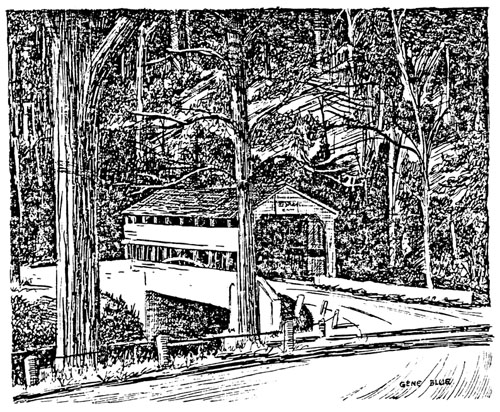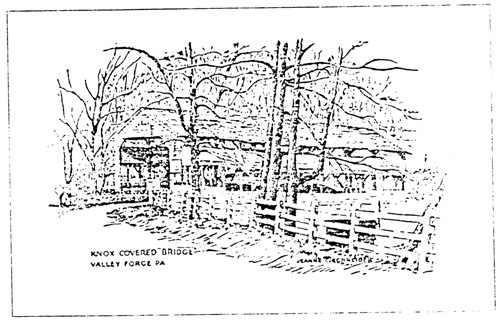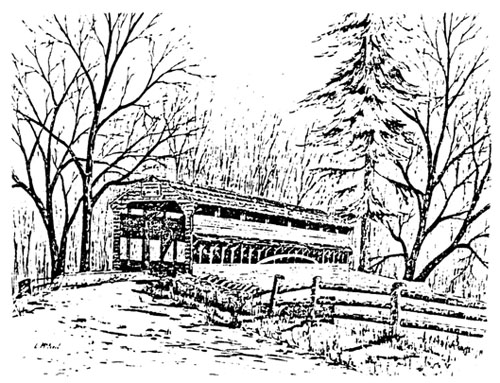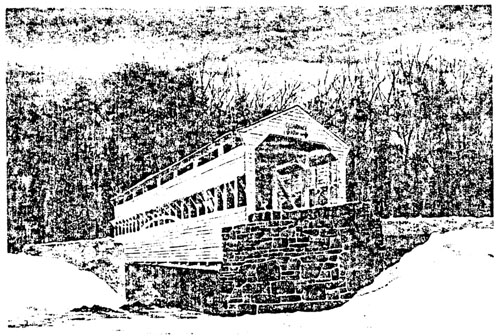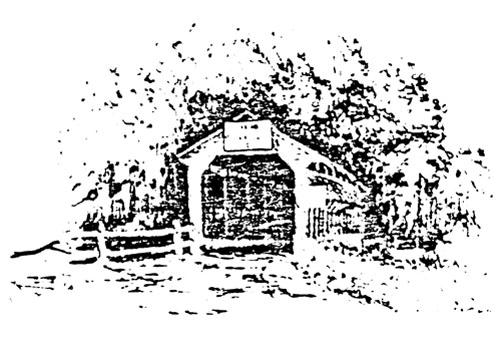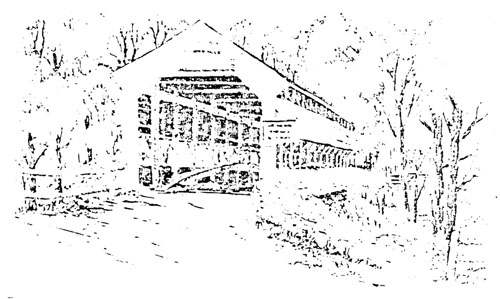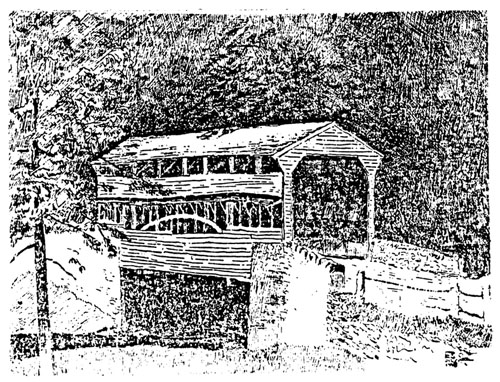|
Home : Quarterly Archives : Volume 28 |
Tredyffrin Easttown Historical Society |
|
Source: July 1990 Volume 28 Number 3, Pages 107–114 The Knox Covered Bridge "By virtue of its proximity to Valley Forge State [now National] Park, "Dr. Arthur E. James pointed out in his Covered Bridges of Chester County, "this bridge is now claimed to be the most often painted and photographed covered bridge in Chester County." Here is a portfolio of some of the many sketches of the span. The Knox Covered Bridge is located at the eastern end of Yellow Springs Road, crossing the Valley Creek about one mile south of the point where the creek flows into the Schuylkill River. Officially, it is known as County Bridge No. 165. It was originally built in 1851 by Ferdinand Wood, at a cost of $843. Its span at that time was 50 feet, and it was constructed on the Burr principle, patented by Theodore Burr in 1817, with an arch-truss and a series of kingposts supporting the bridge. (According to "Eric Sloane, in his book on American Barns and Covered Bridges, Burr's original idea "was to strengthen the series of kingposts with an arch, but what really happened was that the arch became most important and the kingposts merely made the arch stronger".) The bridge was made of white pine, light in weight and resistant to worms and weather. Like other covered bridges, it was covered for protection from the weather, to keep off the rain and snow and sun. The superstructure over the bridge kept water out of the joints, where it might freeze during the winter or cause rotting in the summer, and also kept the bridge from drying [text continued on p. .114]
This sketch of the Knox covered bridge was made by Gene Blue, head of the art department of the Great Valley School District prior to his retirement. A native of Bloomsburg, Pennsylvania, he began his art education at Kutztown State College, his oils, watercolors, and wood carvings have been exhibited in a number of shows along the East coast. The sketch is reproduced here through the courtesy of the Valley Forge Historical Society.
Jeanne Schneider MacNeill, who made this sketch of the bridge, is the wife of the printer Stephen Moylan MacNeill of the Stephen Moylan Press. Over the years the MacNeills have produced hundreds of calendar cards featuring sketches of historic places in Chester County and other places in Pennsylvania, Delaware, and southern New Jersey. Many of these sketches have, also been published in booklet form.
These two impressions of the bridge were done by Linda McNeil. The media specialist at the Valley Forge Intermediate School as well as artist, she is also a member of the Tredyffrin Easttown History Club. Mrs. McNeil has lived in Chester County most her life. She has also made drawings of the Diamond Rock School, the spring house at Great Valley Mill, and other local historic landmarks. Both of these drawings of the Knox bridge are also available as note cards, the lower one in color.
Dennis Minch, who did these two drawings, is a native of Chester County and a self-taught artist. He has worked as a construction draftsman, a free-lance artist, and in the paper design industry, and he has won more than thirty awards for his work. His favorite subject is the Chester County he has grown to know so well, and his work can be found in the collections of Attorney General Dick Thornburgh and former Chief Justice Warren Burger, among others.
This drawing of the bridge, by Edward Samuel jr., is also included here through the courtesy of the Valley Forge Historical Society; it originally appeared on the cover of its Picket Post publication. Mr. Samuel studied in Europe for twenty years, and has also made sketches of a number of the farm houses what were used for officers' quarters during the Valley Forge encampment of the Continental army.
A. Cilley Ward's painting, one of several she made of the Knoxbridge, was done in watercolor. The original painting is in a private collection, and is reproduced through the courtesy of the owner. The Cilleys moved to this area from Blowing Rock, North Carolina. "Jackie" Ward also took advantage of other local places of historic interest, including the Diamond Rock School, as subjects for her paintings. Out under the summer sun. (It has also been suggested that the barnlike appearance was reassuring to horses, oxen, and other farm animals that might otherwise have shied from crossing the running stream, but this is generally considered a less likely explanation.) The 1851 bridge was washed away in 1865 by a flood. A replacement was built that year by Robert Russell at a cost of $1179. With a 65-foot span, it was slightly longer than the original bridge. In 1958 the bridge was damaged by fire. When it was rebuilt by the State, steel girders were added to reinforce and strengthen it. For many years the bridge was known as the Valley Forge Dam Bridge. In the 19th century there were a number of mills and factories, including several textile factories, along Valley Creek, with a dam near what is now Route 23 providing water power for their operation. (In his memories of Valley Forge in a Quarterly eleven years ago [July 1979, Volume XVII, Number 3], the late Ed Ten Broeck recalled a high dam across the creek that replaced the original dam, and backed up the water almost as far as the bridge. The lake formed by the dam, he recalled, was a "very pretty body of water", but with the water level only a foot or so below the road, it also caused floods from time to time.) Today the bridge is usually identified as the Knox Bridge - though there is some disagreement over from which Knox its name is derived, Senator Philander C. Knox or General Henry Knox. That it was for many years known as the Valley Forge Dam Bridge makes it seem more probable that it took its name from the former one. In 1903 he purchased 256 acres of land adjacent to the bridge and moved into the old farm house that had been the quarters of General William Maxwell during the Valley Forge encampment, west of the bridge. He was an attorney and prominent in the Republican party in the early years of this century, serving as Attorney General under President Theodore Roosevelt, and as the Secretary of State in the cabinet of President William Howard Taft. He also served two terms as a United States Senator from Pennsylvania. The suggestion that the bridge was named for General Henry Knox stems from the fact that, during the Valley Forge encampment, the 300-pound commander of the Continental artillery had his quarters in the old farm house to the east of the bridge. As Dr. James noted, however, with his gentle understatement, this derivation of the name "seems somewhat remote". |
